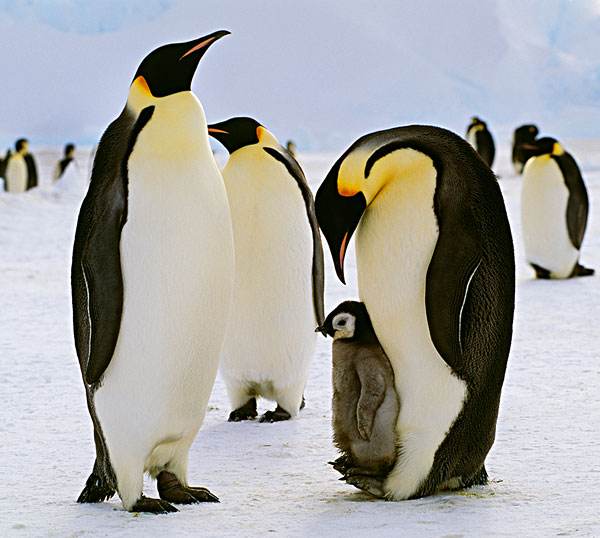Emperor Penguin
IUCN
LCBasic Information
Scientific classification
- name:Emperor Penguin
- Scientific Name:Aptenodytes forsteri
- Outline:Waterfowl
- Family:Sphenisciformes Spheniscidae Pygoscelis
Vital signs
- length:100-130cm
- Weight:20-45kg
- lifetime:20-50 year
Feature
Emperor penguins are the largest of all the different species of penguins.
Distribution and Habitat
Emperor penguins are distributed in many places between 66°-78.5° south latitude on the Antarctic continent, such as Coats Land near the Weddell Sea and Victoria Land near Ross Bay.
Migrant birds: Argentina, Chile, Falkland Islands, Heard Island and McDonald Islands, New Zealand, South Georgia Island and South Sandwich Islands.
Antarctica is the end of the earth, all frozen continents. Due to the extremely harsh climate, only the most cold-resistant plants and animals can survive there. Emperor penguins live in the Trans-Antarctic Mountains, the junction of the Ross Sea and the Ross Ice Shelf, where the Coats Cape is ravaged by the cold wind. When autumn comes, the earth is covered with thick ice and snow, and emperor penguins begin the most special biological behavior - stop eating. Their round bodies, feet, fins and heads are all formed to store heat. In March, the temperature drops to minus 30 degrees Celsius, and emperor penguins are also ready to start a long journey of walk
Appearance
Adult emperor penguins are 100-130 cm tall and weigh 20-45 kg. They are the largest penguins. The emperor penguin is dressed in a black and white dress, with a reddish-orange beak and a patch of orange-yellow feathers under the neck, which gradually fade downwards and are darkest behind the ears. The color of the whole body is harmonious. The neck is light yellow, the feathers of the ears are bright yellow-orange, the abdomen is milky white, the back and flippers are black, and the bottom of the beak is bright orange. The male emperor penguin has a brood pouch of purple skin full of blood vessels between the legs and the lower abdomen, which can keep the eggs at a comfortable 36℃ in the ambient temperature as low as minus 40℃. The light gray-white down feathers on the young emperor penguins can keep out the cold and wind, but they are not waterproof. The waterproof down feathers will not grow until they are almost adults, and slowly replace the down feathers on their bodies. The down f
Details
Emperor penguins mainly live in the sea. They hunt, swim and play in the water. On the one hand, they exercise their bodies well, and on the other hand, they eat and drink enough to conserve their energy for the arrival of the winter breeding season. In winter, emperor penguins have the opportunity to go out for a walk every day, and they will take the opportunity to stretch their muscles.

The swimming speed is 6-9 kilometers per hour, and even a short-distance speed of up to 19 kilometers per hour can be achieved. Dive to about 50 meters below the sea surface, where you can easily find fresh fish in the ice sea, swimming against the current on the surface of the ocean. Then, dive and surface again to breathe, and repeat the above steps. They can also blow bubbles in the cracks of the ice to force hidden fish out.
In the hunting area, emperor penguins will repeatedly dive deep into the sea to find food. They usually dive to 150-250 meters, and the deepest dive is recorded at 565 meters. They can hold their breath underwater for 15-20 minutes. Emperor penguins usually feed on fish, shrimp and cephalopods in the sea.
Antarctic petrels and skuas are the main natural enemies of little penguins. Leopard seals, killer whales, etc. are also the main natural enemies of penguins. In addition, global warming, rising sea temperatures have led to a reduction in food and a deteriorating environment, all of which have posed a threat to the survival of penguins.
There are 45 known emperor penguin colonies in Antarctica. The report states that all of these places are threatened by melting ice. Although the number of penguins will still increase by about 10% before 2050, it will drop sharply by at least 19% thereafter. The number of penguins in two-thirds of the places may drop by more than half, with the most serious situation in the Indian Ocean in the west and the east.
Listed in the Red List of Near Threatened Species of the World Conservation Union (IUCN) - Near Threatened (NT).
Protect wildlife and eliminate game.
Maintaining ecological balance is everyone's responsibility!








